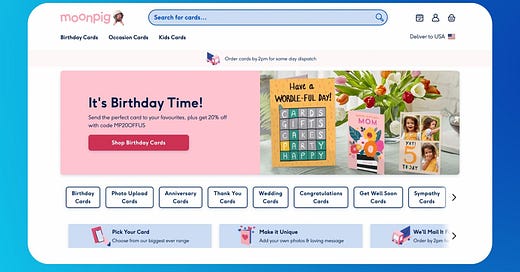How Would We Personalize Moonpig Based on the "Reminder" Data
Personalization → higher customer satisfaction and conversion rates
In this case study, we'll show you how we would personalize the customer experience on Moonpig’s website to increase conversions by leveraging zero-party data they have via occasion reminders.
Before diving into the personalization, let's look at what Moonpig does:
Reading Recommendation: A Comprehensive Guide to MACH Architecture
Moonpig
Moonpig is a technology platform at heart, but it’s known as the leading e-commerce destination for greetings cards, physical gifts, flowers, and personalized gift experiences.
The Background of the Personalization Journey
If you're a business, you know that attracting leads and retaining customers is essential to your success. Moreover, as a business, you understand the importance of understanding your visitors and what they want.
And if you're looking for ways to improve your conversion rates in a direct-to-consumer environment, leveraging zero-party data about customers’ preferences for personalization may be the answer.
Adding this layer of customer understanding to your website, you can create a more tailored experience for all of your visitors, regardless of who they are, which will improve engagement and conversion - ultimately.
The Opportunity
You might think that is it really necessary for businesses to personalize their website experiences for their potential/existing customers?
The answer is a resounding yes, and here’s why.
There is a huge opportunity lying under personalized offers because, according to research by Accenture, 91% of consumers say they are more likely to engage with brands that provide offers and recommendations that are relevant to them.
When done correctly, personalization can lead to higher conversion rates, as well as increased customer engagement and loyalty.
Adding Personalization Layer to Moonpig’s Website
Step 1: Building the Tech Stack
To create the best possible personalization experiences for its visitors, Moonpig needs to leverage the zero-party data from reminders existing, and potential customers are entering.
Moreover, in order to create the best possible personalized experience, Moonpig will need to activate/enrich all of the data points made by the same visitor under one customer profile - with the help of Ninetailed's unified customer profile feature.
For this personalized experience, Moonpig will need the following tech stack:
Step 2: Defining Hypothesis and Methodology
Personalization is key to making sure the visitors are shown exactly what they need before making the desired action, which can help increase conversion rates.
Therefore..
We hypothesize that by personalizing the product recommendations by reminders Moonpig can show its visitors personalized pages with products, messages, and offers they're interested in - increasing the likelihood of clicking through and making a conversion.
The bottom line, to create a personalized web experience, Moonpig needs to leverage the zero-party data they acquire via reminders.
Step 3: Defining Personalization Signals
To create a seamless digital customer experience with a personalized web page, Moonpig will use the following signals:
Occasion: Knowing the occasion will allow Moonpig to show personalized gifts to its potential customers
Date: Knowing the occasion date will allow Moonpig to show the personalized gifts to its potential customers at the right time
Step 4: Personalization Journey
To create a personalized web experience for Moonpig’s visitors, let's define a hypothetical personalization journey:
A visitor lands on Moonpig’s website and fills out the reminder.
After completing the reminder, the same visitor visits Moonpig’s website a couple of days before the occasion and faces a personalized website with tailored product recommendations, messaging, and offers.
Read More: Using Personalized Content to Supercharge Conversion Rates
The Result: Before vs. After
So far, we have talked about the hypothesis, methodology, signals to use, and required technology stack.
Now let's look at the visuals to better understand it.
As we defined earlier, a visitor lands on Moonpig’s website and fills out the reminder:
After completing the reminder, the same visitor visits Moonpig’s website a couple of days before the occasion and faces a personalized website with tailored product recommendations, messaging, and offers:
The Bottom Line
Personalization is a continuous journey, which means that once one implementation is completed, companies will return to the beginning of the framework to analyze acquired data, discuss new ideas, hypothesize further improvements, and so on.
Through continuous learning and experimentation, this strategy enables various teams
content marketing,
growth,
product management,
development
to create meaningful personalization experiences and profitable growth with the composable architecture.









